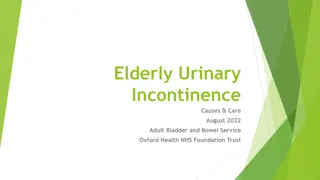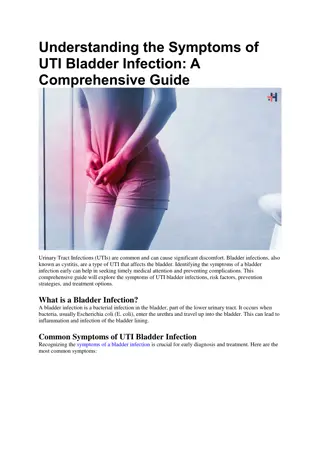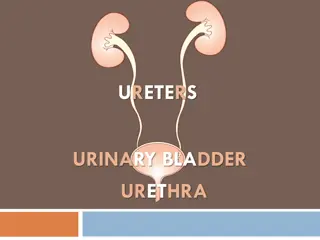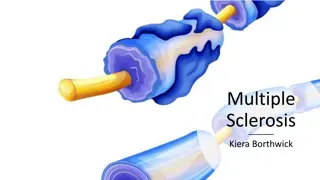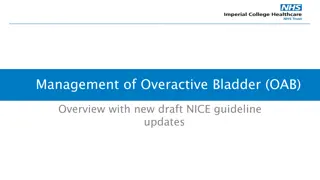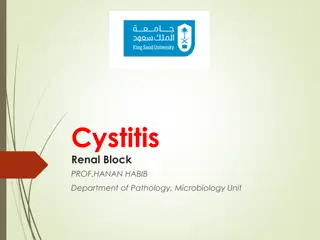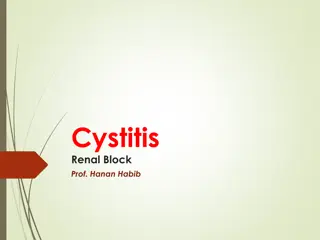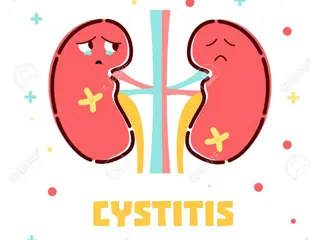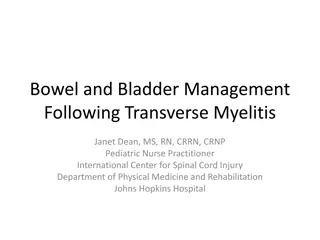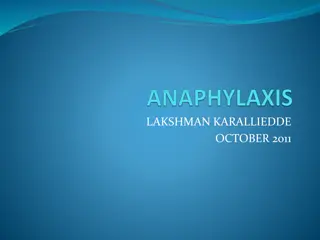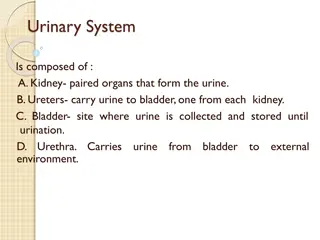Understanding Overactive Bladder: Symptoms and Treatment Options
Overactive bladder (OAB) is a common condition characterized by urinary urgency, frequency, and sometimes incontinence. It significantly impacts quality of life and can affect individuals of all ages, with higher prevalence in older populations. Treatment options include drug therapy, bladder training, self-catheterization, pads, and surgery. However, existing drugs may have unwanted side effects, underscoring the need for better management strategies.
Download Presentation

Please find below an Image/Link to download the presentation.
The content on the website is provided AS IS for your information and personal use only. It may not be sold, licensed, or shared on other websites without obtaining consent from the author. Download presentation by click this link. If you encounter any issues during the download, it is possible that the publisher has removed the file from their server.
E N D
Presentation Transcript
Dr Sandeep Gupta ( M.S, M.Ch , Fellow- 3D Laparoscopic Urology) Assistant Professor, Urology IPGMER Kolkata Consultant Urologist And Renal Transplant Surgeon
Overactive characterized by the key symptom of urinary urgency, with or without urinary incontinence, usually associated with urinary frequency and nocturia. Detrusor muscle over activity (DO) is often, but not always, the underlying condition. The differential diagnosis with stress or mixed urinary incontinence, based on urodynamicinvestigations. bladder (OAB) is a syndrome clinical examination and World J Obstet Gynecol 2013 November 10; 2(4): 65-73
European countries ranging between 12-17%, United States the incidence at 17%. In Asia, the prevalence of OAB is reported at 53.1% Indian J Urol. 2010 Apr-Jun; 26(2): 270 278
The symptoms of an overactive bladder (OAB) have been reported to occur in as many as 1 in 3 women over 75 years of age and 1 in 15 women over 40 years. About half of these women are affected by incontinence. J Obstet Gynecol India Vol. 56, No. 4 : July/Aug 06 Pg 295-297
OAB significantly impairs patients health-related quality of life (HRQL), is also associated to significant comorbidities and high socioeconomic costs
Drug therapy Bladder training techniques Intermittent self-catheterization Incontinence pads and protective equipment Surgery
Drug therapy is becoming increasingly important and is currently the mainstay in the treatment for overactive bladder. However, nearly all of the older drugs produce some unwanted side-effects, which limits their use in some patients.
Antimuscarinics are the mainstay in the pharmacological treatment of OAB. Antimuscarinics act by competitively inhibiting the effects of acetylcholine at post junctional muscarinic M3 receptors on detrusor muscle cells Oxybutynin Tolterodine Solifenacin Darifenacin
Many patients on antimuscarinic do not get sufficient relief from symptoms. Antimuscarinics are not completely bladder-selective causing bothersome adverse effects (AEs). Common side effects are dry eyes, dry mouth, blurred vision and constipation. Approximately 50% of patients discontinue treatment at 3 months [Wagg et al. 2012].
Anticholinergic action may lead to a significantly raised anticholinergic burden and Reduced cognitive function or Dementia in the long term. Ther Adv Drug Saf 2016, Vol. 7(5) 204 216
Mirabegron approved in Japan, United States (Myrbetriq) and Europe (Betmiga). The drug is formulated as Oral Controlled Absorption System (OCAS) tablets. That allows a release of drug from the tablets for an extended period, with more steady absorption, and avoids high peak-to- trough fluctuations in plasma concentration and the considerable food effect of immediate-release formulations. The drug product is available in two dosage strengths of 50 mg once daily dose, orally with or without food)and 25 mg (for patients with severe renal or moderate hepatic impairment)
3-ARs (adreno-receptor agonist) represent the far most abundant subtype in the human bladder Preferentially expressed on bladder tissues including urothelium, interstitial cells, and detrusor smooth muscle. Detrusor muscle relaxes in response to -AR agonists Targeting 3-ARs has a significant effect on reducing spontaneous uncoordinated detrusor contractile activity in human bladder.
Two types of contraction have been observed in the human detrusor muscle: voiding and spontaneous involuntary contractions (IDCs) during bladder filling. Preclinical and clinical studies showed 3 adrenoceptor agonists only reduce the bladder tone and no significant negative effect on the voiding contraction therefore no risk of urinary retention. Ther Adv Drug Saf 2016, Vol. 7(5) 204 216
Animal studies demonstrated that both non-selective and selective 3-AR agonists were able to increase bladder capacity and experimentally induced DO and bladder outlet obstruction (BOO)-associated OAB, without changing voiding detrusor pressure or increasing residual volume. inhibit neurogenic or J Urol 2003; 170: 649-653 J Urol 1999; 161: 680-685
The limitations of antimuscarinics prompted the research of novel pharmacological principles with a distinct mechanism of action and aimed to improve bladder storage phase symptoms, without affecting the voiding phase, and with a better tolerability profile. EUROPEAN UROLOGY 6 3 ( 2 0 1 3 ) 3 0 6 3 0 8
Mechanism of action Agonist of the human beta-3 adrenergic receptor (AR) Mirabegron relaxes the detrusor smooth muscle during the storage phase of the urinary bladder fill- void cycle by activation of beta-3 AR which increases bladder capacity. It improves the storage capacity of the bladder with little effect on the contractile ability of the bladder. http://www.rxlist.com/myrbetriq-drug/clinical-pharmacology.htm
Can be taken with or without food (Cmax) - approximately 3.5 hours. Absolute bioavailability - 29% at a dose of 25 mg to 35% at a dose of 50 mg Metabolized via multiple pathways involving dealkylation, oxidation, (direct) glucuronidation, and amide hydrolysis. Half life 50hrs Excretion - 55% in the urine and 34% in the faeces. http://www.rxlist.com/myrbetriq-drug/clinical-pharmacology.htm
Mirabegron beta-3 adrenergic agonist indicated for the treatment of overactive bladder (OAB) with symptoms of urge urinary incontinence, urgency, and urinary frequency.
The recommended starting dose of is 25 mg once daily with or without food. 25 mg is effective within 8 weeks. Based on individual patient efficacy and tolerability the dose may be increased to 50 mg once daily. It should be taken with water, swallowed whole and should not be chewed, divided, or crushed.
Geriatric Patients Parameter similar to youngers Pediatric Patients The pharmacokinetics not been evaluated. Contraindicated for use in patients with end stage renal disease (ESRD), or in patients with severe hepatic impairment (Child- Pugh Class C) http://www.rxlist.com/myrbetriq-drug/clinical-pharmacology.htm
Nausea, Headache, Hypertension, Diarrhoea, Constipation, Dizziness and Tachycardia
To examine pooled efficacy data from three, large phase III studies comparing mirabegron (50 and 100 mg) with placebo, and pooled safety data including additional mirabegron 25 mg and tolterodine extended release (ER) 4 mg results. Int J Clin Pract, July 2013, 67, 7, 619 632
Efficacy and safety of once-daily mirabegron 25 mg (safety analysis), 50 or 100 mg (efficacy and safety analyses) and tolterodine ER 4 mg (safety analysis) for the treatment of symptoms of overactive bladder (OAB). Co-primary efficacy measures were mean number of incontinence episodes/24 h and mean number of micturitions/24 h. Key secondary efficacy end-points included mean number of urgency episodes/24 h and mean volume voided/micturitions, other end-points included Visual Analogue Scale (TS-VAS) and responder analyses [dry rate (post treatment),
Mirabegron (50 and 100 mg once daily) demonstrated statistically improvements compared with placebo for the co- primary end-points, key secondary efficacy variables, TS-VAS and responder analyses (all comparisons p < 0.05). significant Mirabegron is well tolerated and demonstrates a good safety profile.
In three international, multicentre, phase III studies, comparing mirabegron, at doses of 25, 50 and 100 mg, with placebo, Mirabegron improvements in incontinence episodes and micturition frequency, and was well tolerated. was associated with significant
CONTEXT: Overactive bladder (OAB) treatment guidelines recommend antimuscarinics as first- line pharmacologic therapy. Mirabegron is a first-in-class 3-adrenoceptor agonist licensed for the treatment of OAB and has shown to be well tolerated and effective in the treatment of OAB symptoms. OBJECTIVE: To assess the relative efficacy and tolerability of OAB medications, specifically mirabegron 50 mg versus antimuscarinics in patients with OAB. EVIDENCE ACQUISITION: A systematic literature search was performed on published peer-reviewed articles from 2000 to 2013. This review included randomised controlled trials (RCTs) studying changes in symptoms (micturition frequency, incontinence, and urgency urinary incontinence [UUI] episodes) and incidence of the most frequently reported adverse events (dry mouth, constipation) associated with current OAB medications. The following drugs were considered in addition to mirabegron: darifenacin, tolterodine immediate release (IR) and extended release (ER), oxybutynin IR/ER, trospium, solifenacin, and fesoterodine. Bayesian mixed treatment comparisons (MTCs) were performed for efficacy (micturition, incontinence, UUI) and tolerability (dry mouth, constipation, blurred vision).
EVIDENCE SYNTHESIS: Overall, 44 RCTs involving 27,309 patients were included. The MTCs showed that mirabegron 50 mg was as efficacious as antimuscarinics in reducing the frequency of micturition incontinence and UUI episodes, with the exception of solifenacin 10 mg that was more efficacious than mirabegron 50 mg in improving micturition frequency and frequency of UUI. Mirabegron 50 mg had an incidence of dry mouth similar to placebo and significantly lower than all included antimuscarinics. CONCLUSIONS: Mirabegron 50 mg had similar efficacy to most antimuscarinics and lower incidence of dry mouth, the most common adverse event reported with antimuscarinics and one of the main causes of discontinuation of treatment. Despite being a powerful tool for evidence-based health care evaluation, the Bayesian MTC method has limitations. Further head-to-head comparisons between mirabegron and antimuscarinics should be conducted to confirm our results.
OAB guidelines, such as those from the European Association of Urology [Lucas et al. 2015] and The National Institute of Clinical Excellence [NICE, 2010], currently recommend an anticholinergic as first-line medical treatment and recommend mirabegron as second-line medical treatment.
A randomized controlled study of the efficacy of tamsulosin monotherapy and its combination with mirabegron for overactive bladder induced by benign prostatic obstruction. Ichihara K1, Masumori N2, Fukuta F1, Tsukamoto T1, Iwasawa A3, Tanaka
Abstract PURPOSE: We evaluated the efficacy and safety of add-on treatment with a 3-adrenoceptor agonist (mirabegron) for overactive bladder symptoms remaining after 1-blocker (tamsulosin) treatment in men with benign prostatic obstruction. RESULTS: From January 2012 through September 2013 a total of 94 patients were randomized. Of these patients 76 completed the protocol treatment. In the full analysis set the change in total OABSS during the treatment period was significantly greater in the combination group than in the monotherapy group (-2.21 vs -0.87, p=0.012). The changes in scores for urinary urgency, daytime frequency, International Prostate Symptom Score storage symptom subscore and quality of life index at 8 weeks were significantly greater in the combination group. The change in post-void residual urine volume was significantly greater in the combination group. Although 6 patients experienced adverse events in the combination group, urinary retention was observed in only 1 patient. CONCLUSIONS: Combined tamsulosin and mirabegron treatment is effective and safe for patients with benign prostatic obstruction who have overactive bladder symptoms after tamsulosin monotherapy.
Hypothesis / aims of study- This study was conducted to evaluate the efficacy and safety of add-on treatment with a beta 3-adrenoceptor agonist (mirabegron) for overactive bladder (OAB) symptoms remaining after alpha 1-blocker (tamsulosin) treatment in male patients with benign prostatic hyperplasia (BPH). Interpretation of results- There is solid evidence supporting the efficacy and safety of add-on treatment with anti-muscarinic agents such as propiverine hydrochloride, solifenacin and imidafenacin. The present study demonstrated that add-on treatment with the beta 3-adrenoceptor agonist mirabegron was effective for the patients with BPH whose OAB symptoms were not controled by alpha 1-blocker monotherapy, similarly to anti-muscarinic agents. However, attention should be paid to whether voiding difficulty, acute urinary retention and an increased amount of PVR develop.
New compound, with a novel mechanism of action, is for the first time available in the pharmacological armamentarium aimed to treat OAB. Mirabegron has proven effective across multiple randomized controlled trials, and showed a favourable safety profile Improve adherence to OAB treatment, It can be used for patients with contraindications to antimuscarinics Its effectiveness has been confirmed in patients who discontinued previous antimuscarinic therapy. Decision Must Go.



